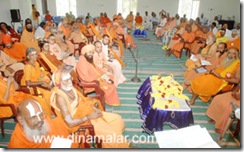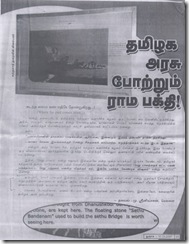Pseudo-archaeology, like linguistics, is non-falsifiable
Historicity means ‘how history is’. Itihasa in Bharatiya tradition means ‘so it was’.
The tradition also holds that Ramayana and Mahabharata are itihasa. Rather than defining historicity in abstract terms by using expletives such as ‘myth’ or ‘faith’, it will be appropriate to take the texts (critical editions as necessary) as they are. Why impute false categories such as ‘myth’ ?
Ramayana is. Shri Rama is.
There are clearly limits to archaeology as a pseudo-scientific discipline. It is pseudo- because the finds from digs have to be put together by the archaeologist’s imagination, thus introducing bias. Many archaeological reports can’t even name the artefacts in the language of the people who left behind these artefacts for later generations to dig up and expound theories.
Archaeology is one discipline, like history, which keeps people busy expounding non-falsifiable theories. The excursus goes on, keeping the academics happy in their chairs.
Anyway, here are some perceptions which point to the limitations of archaeology in ‘proving’ Shri Rama or Rama Setu. The attempted ‘proof’ is bogus, ab initio because the very foundations of the disciplines such as archaeology or history are founded on suggestio falsi, suppression veri. Dead corpses do not speak, not even seals with epigraphs unless the writing system and the language of the dead people are understood.
What goes for archaeology as a pseudo-science also goes for linguistics. Both are non-falsifiable exercises and tend to be abused for political ends. All developments in time and space cannot be explained by fundamental principles yielding many schools of history. Archaeology and linguistics produce limited empirical evidence of only a few variables in a multi-variate phenomenon called human evolution or development. Some neo-historians use post-structuralism connecting anthropological enterprises and Hegelianism (which may be called anthropological historicism). This is as much hypothesis as the hypothesis that paramaatman exists. Some also say that what exists is itself unreal, muddling the philosophy of historicity further.
There are joys of life which can be cherished without ‘historicity’. Legacy is the thing because the time-continuum defines the present. If a samajam does not exist in naalu per, the four people who carry the corpse to the smas’aanam, and if nihs’reyas is all that counts, there is no need for archaeology, nor for linguistics.
The aadi kaavya, itihasa Ramayana of Valmiki is an extraordinary document of the ‘goings’ (ayana) of vigrahavaan dharmah. This journey of dharma is justification in itself for it to be adored and cherished as the fifth veda.
One view, therefore, is that the very question seeking ‘historicity’ of traditions is a futile exercise. Leave things be without hoping for a searchlight to reveal our past. If fears are liars, hopes are dupes.
The social memories are sacred, as sacred as the tarpanam performed for the pitr-s. For without pitr-s, there is no identity for the present or future generations. Shri Rama is our pitr and hence the tarpanam performed by thousands, on Ashadha or Mahalaya Amavasya at Agnitirtham in Rama Setu. This performance is more meaningful than the intellectual gymnastics of people like Romila Thapar or even Ambika Soni’s withdrawn affidavit or falsehoods uttered by her in Bharatiya Parliament.
kalyan
November 18, 2007
Open Forum: On the historicity of Ram
By Biman Bihari Roy
ARCHAEOLOGICAL evidence cannot be the only proof for any historical person or event. Reasonable supposition too is considered as a proof in history. Above all, there are four leading criteria of judgement. These are: (a) traditional rumours or hearsay (b) literary evidence (c) genealogy (d) adjustment of particular place and point of time and person.
The terminological concept of Sanskrit ‘itihasa’ and English ‘history’ are not akin. Itihasa is a science of seeing past events and eventful careers to have guideline for the present and future life. So itihasa is social literature with wars as parenthesis. On the contrary, history is merely a methodically collected records of past politics and politics in present day history. So history is war literature with the remarks on society as parenthesis. Though now it has been extended to the study of social, economic and cultural fields. Secondly, shortcomings are found in the so-called scientific history too. Therefore, it is quite natural to have some limitations in itihasa.
In the Ramayana, an abridged family tree of Sri Ramchandra is found. His detailed genealogical table is also available in the Puranas etc. Reference of Ram is seen in various ways. There are so many books in Sanskrit literature containing the name of Ram. Besides numerous human habitations, parks, lakes, temples, etc. have been engraved with the name ‘Ram’. Also the name ‘Ram’ is found to be used as name, middle name and surname of innumerable persons. Undoubtedly, it indicates careful love and respect of the people regarding some ‘Ram’.
Sri Ramchandra is a God of the second form, upon whom godhead has been attributed for his execellence and nobility. Thus i.e. in accordance with the study of itihasa (as it was then) Ram has been elevated to godhead and thereby related to religion. It is just like what Sri Krishna, Buddha, Mahavir, Guru Nanak, Sri Chaitanya, Vivekananda, Pranavananda and such others have been. Naturally question comes: Is it deserving to deny one’s historical existence if he/she has been eulogised as God or Goddess and thus be related to a religion?
The term “Ramayana” itself means the “itihasa of Ram” by its formation. Besides, it is itihasa as the story began to be composed by Valmiki according to Adi Kanda. Moreover, Valmiki himself characterised Ramayana as itihasa in canto 129 of Lanka Kanda. Another such reference is seen in canto 111 of Uttar Kanda also. The story of Ram has been characterised as itihasa in the Mahabharata also (in the story of Markandeya). Poet Bhavabhuti of the Gupta era also concurred that Ramayana is history. The history of Ram has been narrated in almost all the Puranas and Upapuranas. Ram was referred to in the Rig Veda itself (10.93.14) as a mighty warrior along with other Khsatriya kings. Except this Ram, there are some other Rams in the Vedic literature. e.g. in Shatapatha Brahmana (4.6.1.7) Ram a teacher, in Jaiminiyal Upanishad (3.30.1, 4.16.1) and in Aitareya Brahmana (7.2.73), Ram a man of priestly family. Therefore Ram of Rig Veda is the mighty Khsatriya king of the Ramayana. Are all these references bogus? Sir William Jones admitted the historicity of Ram. Jacobi considered Ramayana to have been the result of the blending of history and allegory.
Finding out of a historical truth needs logically critical analysis. The question of theism-atheism which are being raised by the motivated politicians is irrelevant in this context.
According to the descriptions in the Yuddha Kanda, it appears that a long narrow hilltop had been in the sea between India and Sri Lanka. That was adjoined by Nala with the help of vanara sena. Vanara does not mean monkey at all. “Monkey” was the “cult” of the then people of Kiskindha.
(The writer can be contacted at 514/A/4, Ashoknagar, PO-Ashoknagar. Dist: North 24-Pargana-743 222, West Bengal.)
http://tinyurl.com/37j96d
Archeology and Babri Masjid
Facts of history cannot be altered Author: Prof. B. B. Lal Publication: The Hindu Date: July 1, 1998
Prof. B. B. Lal, Director General (Retd.), Archaeological Survey of India writes:
Under the caption ‘Tampering with history’, the Editor of The Hindu, (dated June 12, 1998) dealt with the reconstitution of the Indian Council for Historical Research (ICHR). Since I happen to be one of the 18 persons nominated by the Government on the Council, the editor took the opportunity to have a dig at me. He made three distinct allegations. To quote: (i) his (i.e. my) initial conclusion was that there was no evidence to suggest the ‘historicity’ of the Ramayana; (ii) even now he refuses to hand over his field diaries to ASI and throw these open to fellow archaeologists; and (iii) professor Lal began echoing the Sangh Parivar and even claimed to possess ‘clinching’ evidence suggesting-the Babri Masjid stood on the ruins of a Hindu Temple.
In regard to the first allegation, let me make it absolutely clear that at no point of time did I ever say that there was no
evidence about the historicity of the Ramayana story. My first paper on the subject appeared in 1981 in Antiquity, a renowned research journal published from Cambridge, England. In 1988 the ICHR organised an international seminar in New Delhi at which I presented a 60-page paper entitled “Historicity of the Mahabharata and the Ramayana: What has archaeology to say in the matter?” Finding in it something that went counter to their views, the then authorities of the ICHR withheld the publication of the paper. Thereafter, when another journal published it, there was a great hue and cry, as if the heavens had fallen.
Anyway, in 1993 came out my first volume under the project ‘Archaeology of the Ramayana sites’. In it I categorically
restated he combined evidence from all five sites excavated under the project shows that there did exist a historical basis
for the Ramayana. I do not know why the editor has chosen to misrepresent my viewpoint and give an altogether opposite
impression to the reader.
The allegation that I am withholding the documents from the Archaeological Survey of India is again outrageously baseless. The Survey is the custodian of all the documents, including field diaries, plans, sections, photo negatives, and the entire excavated material; and, as my information goes, the Babri Masjid historians did see the same a few years ago.
Why all this fuss now?
Finally, to the evidence suggesting that the Babri Masjid stood on the ruins of a Hindu temple. Since it is an issue about
which the entire country would like to know the facts, I am presenting the same in some detail. The excavations at Ayodhya were part of a much larger project called ‘Archaeology of the Ramayana Sites’. The primary objective was to ascertain the antiquity of this site and compare the same with that of the other sites associated with the Ramayana story.
Thus, it was decided to excavate at Ayodhya as many spots as possible to ensure that the lowest levels were not missed.
Fourteen different areas were chosen for the operations, such as Hanuman Garhi, Kaushilya Ghat, Sugriva Tila, etc.; and the Janmabhumi area was just one of them.
In the Janmabhumi area, where there existed the Mandir-Masjid complex, a trench was laid out of the southern side of the
complex, at a distance of hardly four metres from the boundary wall. In this trench, just below the surface, parallel rows of
pillar-foundations, made of bricks and stones, were met with. While some of these fell well within the excavated trench, a few lay underneath its edge towards the boundary wall of the Mandir- Masjid complex. Since affixed to the piers of the Masjid there were many pillar-shafts carved with Hindu gods and goddesses, it was but natural to enquire if the pillar-foundations encountered in the trench had anything to do with the pillars incorporated in the mosque, which evidently originally belonged to a temple.
An overenthusiastic Babri Masjid archaeologist, in his effort to deny the entire pillar evidence, published a propaganda booklet in which he stated that these were not pillar foundations but walls. The most amusing part, however, was that he just drew some white lines interconnecting the pillar bases on the photographs concerned and thereby wanted us to believe that these were walls. What a mockery of archaeology! Another Babri Masjid archaeologist, while conceding that these were pillar bases all right, suggested that the structure concerned was no more than a mere cowshed. No doubt for a person coming from a rural background the cowshed idea was a very exciting one, but he conveniently overlooked the fact that this structural complex had as many as four successive floors made of lime – something unheard of in the case of cowsheds.
On February 10, 1991, while delivering a lecture at Vijayawada on the “Ramayana: An archaeological appraisal” to the distinguished scholars assembled for the Annual Conference of the Museums Association of India, I was asked about the inter-relationship between the pillar foundations encountered in the trench excavated by me and the stone pillars incorporated in the Babri Masjid and further whether there was any temple underneath the Masjid. I replied, as any archaeologist would have: if you do want to know the reality, the only way is to dig underneath the mosque. When this view was published in The Hindustan Times, New Delhi, on February 12, 1991, a horde of Babri Masjid historians
pounced on me accusing that I made this suggestion under the impetus of the current Hindutva campaign, and added that Mr. Lal by arguing fresh excavations at the site of the Babri Masjid in Ayodhya would be fulfilling the demand of those who wanted the Babri Masjid to be demolished to construct the temple at that site. (The Hindustan Times, February 13, 1991.)
To the foregoing I issued a rejoinder (The Statesman), February 18, 1991. Further excavation within the floor area of the Babri Masjid without in any way harming the structure is necessary to know what actually preceded the mosque at Ayodhya. Why should the contending parties shy away from further excavation, unless they are afraid of facing the truth? Unfortunately, the foregoing suggestion fell on deaf cars and tension between the two parties continued to develop.
Curiously, events take their own course. On December 6, 1992, the Babri Masjid was demolished by Kar Sevaks who had assembled in thousands at the site. A regrettable event in itself, the demolition incidentally brought to light a great deal of
archaeological material from within the thick walls of the Babri structure. It included, besides sculptured panels and images, architectural components such as amalaka, sikharas, doorjambs, etc., three inscriptions on stone.
Of the above-mentioned three inscriptions, the largest one, inscribed on a 1.10x.56 metre slab and consisting of 20 engraved lines, has been published by Professor Ajaya Mitra Shastri of Nagpur University in the Puratattva (a reputed scholarly journal of the Indian Archaeological Society). No. 23 (1992-93), pp. 35 ff. (Professor Shastri is a distinguished historian and a specialist in epigraphy and numismatics.) The relevant part of his paper reads as follows: The inscription is composed in high-flown Sanskrit verse, except for a small portion in prose, and is engraved in the chaste and classical Nagari script of the eleventh-twelfth century AD. It was evidently put up on the wall of the temple, the construction of which is recorded in the text inscribed on it. Line 15 of this, inscription. for example, clearly tells us that a beautiful temple of Vishnu-Hari, built with heaps of stone (sila-sam hati- grahais) and beautified with a golden spire (hiranya-kalasa-
srisundaram) unparalleled by any other temple built by earlier kings (purvvuirapyakritam kritam nripatibhir) was constructed. This wonderful temple (aty-adhutam) was built in the temple-city (vibudh- alayni) of Ayodhya situated in the Saketamandala (district, line 17) showing that Ayodhya and Saketa were closely connected. Saketa being the district of which Ayodhya was a part. Line 19 describes god Vishnu as destroying king Bali (apparently in the Vamana manifestation) and the ten-headed personage (Dasanana i.e. Ravana).
The inscription speaks for itself and no further comments are necessary. It has been contended by the Babri Masjid Historians that these images, architectural parts and the inscribed slabs had been brought by the Kar Sevaks from elsewhere and surreptitiously placed there. This contention, however, does not hold good, since there are photographs to contradict this stand: for example, the two photographs published by India Today on p. 33 of its issue dated December 31, 1992. Here, the Kar Sevaks are seen carrying a huge stone-slab bearing a very long sculpted frieze, after having picked it tip from the debris. The above-mentioned historians also allege that the inscription has been forged. This is behaving like the Village School Master of Oliver Goldsmith, who, hough vanquished would argue still. So many eminent epigraphists of the country have examined the inscribed slab and not one of them has even remotely thought that the inscription is forged.
In this context, it may not be out of place to mention that hundreds of examples are available ofthe destruction of temples
and incorporation of their material in the mosques. Right in Delhi there is the example of the Quwwat-ul-Islam Mosque (near the Qutb Minar) which incorporated parts of a large number of temples that had been destroyed. Or at Ajmer, there is the well-known Arhai-dinka-jhonpra, presenting a similar picture. From the foregoing it is abundantly clear there did exist a twelfth-century temple at the site, which was destroyed and some of its parts incorporated within the body of the Babri Masjid. Some other parts, like the stone-pillars, were placed alongside the piers of the Masjid, to show them off. Some other pieces, not used in either of the foregoing matter, were thrown away in a nearby depression, like the ones recovered by the Public Works Department of the Uttar Pradesh Government in June 1992 in the course of the leveling of the adjacent area.
Had my suggestion to carry out trial excavation underneath the floor of the mosque without; in any way damaging the structure itself been implemented. it would naive averted the disaster. But who cares for sane advice? Anyway, let it be remembered that by blindfolding yourself you cannot alter facts of history!
http://www.geocities.com/indianfascism/Babri/archeology.htm
Ramavats (Ramanandis)
Doctrines Though the fifth successive leader and teacher of the Visista Advaita school founded by Ramanuja, Ramananda is not associated with any particular doctrines. With the exception of some bhajans, devotional hymns, Ramananda left no written works. However, he did start a popular religious movement in northern India using the vernacular for teaching rather than Sanskrit. This was reinforced by considering all devotees as equal, thus ignoring caste. Traditionally, Ramanandi’s closest followers were a brahman, a barber, a leather-worker, a Rajput, and a woman.
The supreme deity of the sect is Rama and Sita as a combined deity. Rama is the visible form of the supreme deity, Isvara, together with Sita as his maya, power and creative activity.
The main source of doctrine is Valmiki’s Ramayana. The story is of Rama’s birth, his marriage to Sita, his exile, the abduction of Sita by Ravana the demon king, the battle leading to the killing of Ravana, and the recovery of Sita. Rama is a man upholding dharma, cosmic order. He is a supreme example of dharma, following this all through his life whatever the cost. To Rama “Dharma is the highest truth in the world, and is said to be the root of heaven.” In the Ramayana there is hardly any mention of moksha, salvation. Dharma is the most important doctrine and is the means of obtaining heaven, Rama showing the way through his life.
Rama is seen as the ideal man and an example of ideal human relationships. He was the ideal son, an ideal husband and Sita was an ideal wife. Rama and Sita represent the Indian ideal of marriage. He is also an example of brotherly love with Laksmana and Bharata and is an ideal helper of the oppressed. All through the Ramayana, Rama is portrayed as a hero who fights only for dharma. When he breaks the mighty bow of Shiva, he shows he is not only the strongest of men, he is more powerful than the gods. Rama is the ideal king and is destined to rule over Ramarajya as the ideal kingdom on earth. When he is fifteen he kills Tataka, a female raksasa, demon, in accordance with rajadharma, the dharma of the kingdom, and in the climax of the Ramayana he kills Ravana. In the first and sixth books of the Ramayana, Rama is depicted as an avatara, incarnation, of Vishnu who comes to earth as a human warrior to kill the demon Ravana.
The Adhyatma Ramayana, a late fourteenth century text, is in the narrative form of a conversation between Shiva and Parvati to provide an advaita, nondualistic, philosophical orientation to the teachings of the Rama cult. Rama is Brahman, the Absolute, who takes human form to accomplish his divine purposes. The text stresses bhakti, devotion, towards Rama. This is a central scripture to the Ramavats.
Tulsidas’s Ramcaritmanas, written about 1574, is the most popular book ever in northern India, and sees Rama as nirguna Brahman, Absolute Reality, and also stresses the primacy of bhakti, loving devotion to Rama as a personal God. In the Ramcaritmanas all the characters of the Ramayana are devotees of Rama, including Ravana and the demons. This devotional theory says that even an enmity to God is one of the means of reaching God.
Devotees believe that chanting Rama’s name and meditating on the main happenings in his life will lead them to God. They also worship Hanuman, the monkey god, as a great follower of Rama and a great magician. Parts of stories about Krishna’s life are borrowed to describe Rama as a child.
History Ramananda is a mysterious figure from northern India. One text says he was born in 1299 and lived in Benares.
Ramananda is an important part of the bhakti movement. After Shankara, most sectarian and revivalist movements developed interdependently in their common stance against advaita nondualism. The movement spread through Maharashtra into the Hindi-speaking areas of northern India and to Bengal. Worship in the Hindi-speaking areas was focused on Vishnu as Rama; in Bengal it was focused on Vishnu as Krishna. Different sects emerged and the main sect of Rama in the Hindi-speaking areas was the Ramavats founded by Ramananda.
In the language of the sants, holy men such as Kabir, and other poet-saints, the god Rama became less an avatara of Vishnu, more the totality of the divine presence. Tradition maintains links between the poet-saints of the different sects. Ramananda is said to have been the guru of Kabir and one hagiology, the Bhaktamal of Nabhadas (c. 1625), describes Ramananda as the guru of Kabir, Ravidas, and Pipa.
The line of descent from Ramanuja and the Shri Vaishnavas may not be as close as claimed but might be an attempt to compensate for the lack of written works by Ramanuja. However, it seems that Ramananda did derive inspiration from South India. In northern India, he and his guru were influenced by tantric practices through contact with the Nath cult.
Rama, the god of the Ramavats, is traced back into Aryan tradition. Indian tradition accepts that Rama belonged to an ancient Indian dynasty. But it is not possible to prove Rama’s historicity by Western objective historical methods. Some scholars believe that the later events in the Ramayana may have been historical, involving the Aryanisation of South India, and the story of Rama is an allegorical portrayal of those events.
Symbols An important work by Whaling analyses Rama in terms of “symbolic development.” In the Ramayana Rama already fuctions as a symbol and as the Rama tradition develops, different levels of meaning are opened up in the Rama symbol. At the outer level, he is an example of kingship and ethical purpose and an avatara of Vishnu, while at a deeper level he is the devotional Lord, the object of bhakti. “Rama continues to function as a symbol, but ever-deeper levels of meaning are opened up in the Rama symbol so that He is realised to be the Lord, the Ultimate, the Foundation of everything that is.” The Rama symbol functions at different levels of meaning, remaining an outward symbol for most Indians but having a deeper meaning for some and “at the deepest level of all Rama ceases to be an objective cognitive symbol and becomes a non-cognitive, non-objective symbol that is ‘real’ for the devotee, and the context in which life and action finally have meaning” (Whaling 1980, 6).
In the autumn at the time of the festival of Dasahra or Vijayamadasami, held to celebrate Rama’s victory over Ravana, Tulsidas’s Ramcaritmanas is the basis for Ramalilas, dramas on the life of Rama. The best known Ramalila is in the grounds of the palace of the maharajah of Benares and lasts thirty-one days, with pilgrims coming from far away. There are other equally well-attended Ramalilas in many Hindi-speaking towns and cities. The Ramcaritmanas is also the focus of private devotion all through the year. Individuals and religious associations employ brahmans to chant it continually from start to finish or they do this themselves.
Renouncers have a sacred fire and apply ash from this twice a day on their bodies.
Adherents This is the largest Vaishnava ascetic sampradaya, order. It competes with the Dashanamis, its Shaiva rivals, for the best place at pilgrimage sites such as the Kumbha Mela. Ramavats are divided into renouncers, non-renouncers, and householders. The householders provide financial support for the other two groups. Non-renouncers live in monasteries and hermitages, found in large numbers throughout western and central India, the Ganges basin, the Himalayan foothills, and Nepal. Renouncers are the most revered Ramavats and they travel in small groups which are termed a khalsa, an itinerant monastery. They follow an annual cycle to visit all the major Vaishnava pilgrimage sites at the astrologically correct time (Harris in Longman 1994, 194).
Rama is a popular god throughout the Hindu world. Gandhi died with an invocation to Rama on his lips. A recent television series of the Ramayana was an astounding success all over India.
Headquarters/
Main Centre Ayodhya, northern India, the birth-place of Rama. The actual site of Rama’s birth was occupied by a mosque, recently demolished by non-renouncer Ramavats and other militant Hindus. A temple of Rama is to be built there.
http://philtar.ucsm.ac.uk/encyclopedia/hindu/devot/ramav.html
By Sandeep
This post is partly a response to several comments I received on my posts related to the Ram Sethu project. The greater part, however, is my education, an attempt to trace the Rama (and Ramayana) consciousness in Tamil Nadu.
The Sangam corpus is typically used as a reliable source for a lot of historical information about Tamil Nadu. Its historicity spans 200 BCE to 200 CE. It is therefore reasonable to start tracing the Rama tradition in Tamil Nadu from this source. In general, the Sangam Literature contains numerous references to Lord Vishnu (for example, in Paripaatal) and his prominent avatars like Narasimha, Rama, and Krishna. Purananuru, a collection of about 400 poems contains a reference to Ramayana.
Post-Sangam, the Alvars were the true pioneers of the Vaishnava bhakti movement. In a way, they were the spiritual progenitors of Ramanuja, founder of Sri Vaishnavism, who held them in reverential esteem. The term Alvar means one who is immersed. Between the twelve of them, they composed what is known as the Natayira Divyaprabandham (4000 Divine Veses) dedicated to all forms of Lord Vishnu. References to Rama are abundant in the Alvar literature, most notably in the poetry of Kulashekara Alvar , who dedicated his life to worshipping Rama. Most notable is that in an age where the caste system had reached deplorable levels, Thiruppan, an untouchable was elevated to an Alwar by the sheer force of his devotion.
Kambar’s Ramavatharam–popularly, Kambaramayanam–is the next definitive epoch-making work that helped spread the Rama tradition throughout the Tamil land. Inspired by Valmiki, Kambar retold the epic in about 10,000 verses. This work contributed not just to classical Tamil literature but over time, became inseparable from routine Hindu religious worship. To date, the entire Ramavatharam is recited in the Aadi month of the Tamil calendar. It is also part of regular worship, chanted alongside Sanskrit mantras.
In general, the Sri Vaishnava movement holds Rama in special reverence. It spread its wings really wide to spread the message of Rama in Tamil Nadu and beyond. A key defining concept of Sri Vaishnavism is Sharanagati or complete surrender. This in turn has its roots in Vibhishana’s surrender to Rama. From Nathamuni to Yaamunacharya to Ramanuja, every major Sri Vaishnava saint and philosopher composed an array of elaborate literature on Rama and helped build Rama/Vishnu temples across Tamil Nadu.
The next saint-philosopher to greatly propagate the Rama movement was Sadashiva Brahmendra or Upanishad Brahmendra, who lived in Tiruchinapalli in the 18th century. He initiated the concept of Rama Parabrahma or Rama as Brahman. The most famous nay, celebrity-follower of Brahmendra was Thyagaraja whose entire life centered around Rama. The Tanjore-Cauvery belt in Tamil Nadu came under the Rama-bhakti spell owing to these influences.
Other stalwarts of the Rama bhakti movement include the legendary Vedanta Desikar, who wrote a thousand verses on Sri Rama’s Paaduka (sandals/footwear), Sridhar Sastry Aiyyaval, C.Rajagopalachari, whose Chakravarthi Thirumagan is an acknowledged modern classic, the Kanchi Paramacharya, and Ahobila Jeeyar.
The Rama bhakti movement also showed manifestations in several areas such as art, music, dance, drama, and folk. To this day, art forms such as Oothakadu, Sulamangalam, Terukoothu, and Bhagavata Melas focusing on the Ramayana theme are performed in various parts of Tamil Nadu. These have an unbroken existence of about a thousand years. Gopalakrishna Bharati’s Nandanar Charitram, popular even today is based on Arunachala Kavi’s Rama Natakam. Nandanar Charitram has been adapted, revised, and customized several times over by eminent artists like Thanjavur Krishna Bhagavatar, and more recently, Balasaraswathi.
The fact that one of the holiest Hindu pilgrimage spots, Rameshwaram, is in Tamil Nadu speaks volumes. No less than Rama had himself installed two lingas, which are housed in the magnificent Ramanatha Swami temple.
The Rama tradition also finds its expression in the names people give their children. Raman, Rameshwaran, Ramaswamy, Ramabhadran, Sitaraman, Sivaraman, Sivaramakrishnan, Ramasubramanian, et al . That more than anything, testifies the continuing significance and Rama-consciousness in Tamil Nadu. This, despite state-sponsored denigration of everything Hindu and rampant conversion activities.
http://tinyurl.com/ysc2ug
Friday, September 28, 2007
Romila Thapar’s Double standards and Half Truths
This is with reference to Prof. Romila Thapar’s article ‘Where fusion cannot work — faith and history’ (The Hindu, 28-Sep-2007).
While every scholar is entitled to his or her own views on the historicity of Sri Rama it comes as a shock to see a scholar of Prof. Thapar’s repute set double standards for Indic Divinities, as against those from other traditions – particularly non-Indic and/or Abrahamic. For example, she states that in the case of Sri Rama, the variant versions of the story is, in itself, not evidence of historicity and that if the variants contradict each other as they do, this may create problems for those who believe that only one of the variants is true.
In the case of Jesus narrative variants have been ruthlessly suppressed. Now scholars are discovering ancient narratives which contradict synoptic Gospels at every major point – like the family life of Jesus, role of Magdalene, the supposed betrayal of Judas etc.
Even the accepted Synoptic Gospels present invented genealogies of Jesus (which have no common names for 14 generations) because the authors wanted Jesus to be hereditarily linked to David To crown it all no external sources have been discovered to date outside the body of Gospel literature (both Gnostic and Synoptic) to ascertain the historicity of Jesus. Even Dead Sea scrolls are silent on Jesus.
Also unlike in the case of Sri Rama where His actions turned out to be trend setting examples in the mythological and devotional literature of South Asia, every supernatural act ascribed to Jesus in Gospels had their precursor in the past mythological Divines. From turning water to wine (Dinoysius) to his resurrection from the death (Tammuz), Jesus had mythological ancestors popular in Judaeo-Roman-Hellenistic traditions.
Yet our learned professor has no problem in declaring the historicity of Jesus whom she also qualifies as Christ – the Anointed one – a Christian claim based on what many Hebrew scholars consider as misinterpretation of verses from Jewish scripture.
Coming back to the claims on the historicity of Ramayana, most historians who have no ideological vested interests accept the historical kernel of Ramayana. They may differ and debate on the details. Thus Dr.B.B.Lal the eminent archaeologist who excavated the Ramayana sites concludes that Ramayana is not a figment of imagination but based on historical events which were popular in the memory of the people which Valmiki composed into an epic narrative. Dr.B.B.Lal dates Ramayana events to 700 BCE. The unfortunate tendency of certain historians who put ideological vested interests over objective scholarship resulting in suppressing the conclusions arrived at by Dr.B.B.Lal after the Ramayana project, being presented in the ICHR meeting of 1988 has been explained by the eminent archaeologist in the very pages of ‘The Hindu’ itself (‘Facts of history cannot be altered’, July 1 1988).
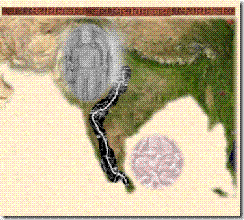
Hence when ASI stated that Ramayana has no historical basis it was simply indulging in ‘suppressio veri suggestio falsi’ game.
That Ramayana in its general outline known today, was also known to people of India even prior to Sage Valmiki, is well attested by varied literary evidence from across the nation. particularly from the South. Like for example from ancient Tamil Sangham literature which mentions an event related to Rama that goes unmentioned in Valmiki wherein Sri Rama plans the military strategy under a banyan tree in Rameshwaram and the birds whose sounds disturb the meeting fall silent as Sri Rama commands them to be quiet (Aham: 70:15).
The mention of Rama here makes it clear that the lore of Sri Rama coming to the south and winning in the battle against the demon of Lanka is not something that originated in the North and later spread over to the South but that was as strong in the south Indian tradition as it was in north India even during the period historians usually attribute to Sage Valmiki Ramayana, that is around 200 BCE.
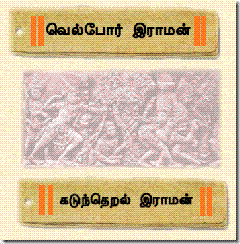
http://i171.photobucket.com/albums/u295/aravindan_neelakandan/ram_ram.gif
This is also roughly the time attributed to Sangham literature. In fact the Sangham mention of Sri Rama also hints at Rama’s divinity as his words not only had a supernatural effect on the birds but also the lines speak of his words as being scriptural in nature (‘Aru Marai’’வெல்போர் இராமன் அருமறை’).
Even stranger is the claims that Prof.Thapar makes about the Buddhist Jataka variant of Ramayana that it does not mention the abduction of Sita or Sri Rama’s war with the demons. Historian Himansu Bhusan Sarkar explains this particular aspect of the Jataka tale variant of Ramayana thus:
“The non-mention of southern topics does not, of course, prove anything., as the Jataka-stories were framed only with limited objectives and had no compulsive motive to narrate the whole story but by the third century AD the story had assumed its present features, because, in a Chinese collection of some Jataka stories which were translated by a Sogdiana monk between AD 222 and 280, the episodes of Rama’s exile , the abduction of Sita by Ravana, the duel of the latter with Jatayu, of Sugriva and Vali, the construction of a bridge to Lanka, the ordeal of Sita have been drawn in outline.” (pp 103-104, The Ramayana traditions in Asia, Sahitya Akademi 1989)

http://i135.photobucket.com/albums/q137/aravindan_photos/jain_ramayan.gif
Equally amusing is her claim about Jain Ramayana ‘variants’ as she calls them. From Puama-cariya of Vimala-Suri (end of 3rd century CE) to Rama Charitha of Devavijaya-ganin (1596 CE) one finds the theme of Rama-Ravana battle in Jain Ramayans. Also Prof. Thapar claims in her article that in the Jain version ‘Ravana is not a demonic villain but a human counter-hero’ But in Puama-cariya considered the earliest Jain version of Ramayan, Ravana is mentioned as leader of demons (PC: 3:9) More relevant to the issue in hand, the Jain Ramayan specifically mentions the Vanaras building a bridge to Sri Lanka. (PC: 3 v.12)
Another great Jain monk who hails from the southernmost part of India, Saint Illango in his immortal Tamil epic ‘Chilapathikaram’ (usually dated as 200-300 CE) compares the leaving of his epic hero Kovalan of his hometown to Sri Rama leaving Ayodhya.
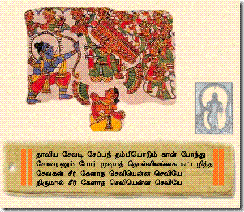
http://i135.photobucket.com/albums/q137/aravindan_photos/silapathikaram1.gif
And in the epic he mentions how Tamil shepherds were singing and dancing the praise of Sri Rama destroying the demons of ancient Lanka and in through their song the Jain monk praises Sri Rama as the incarnation of Maha Vishnu and laments that the ears that hear not His praise exist in vain.
Clearly by 200 CE if not before, Sri Rama going to Lanka and killing the demons there and veneration of Sri Rama as the avatar of Vishnu have all become part of the Tamil devotional tradition and day to day culture.
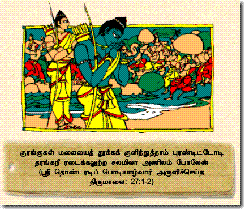
http://i135.photobucket.com/albums/q137/aravindan_photos/squirrel.gif
There is also the strong possibility that many popular devotional aspects of Rama tradition –like the squirrel helping the Sethu Bandhan which finds first literary mention in Thirumalai: 27 – that are found throughout India may have originated and spread from South India itself.
Clearly it is not only ASI which has been playing the ‘suppressio veri suggestio falsi’ game.
That said one cannot but agree with Prof. Thapar when she states that a search for a non-existent man-made structure takes away from the imaginative leap of a fantasy and denies the fascinating layering of folk-lore. While rejecting the literalists, one is at a loss to understand why Prof. Romila Thapar fails to see the cultural dimension of the natural formation that inspired the imaginative leap of not just fantasy but also devotional literature of a nation and the fascinating layering of the same by folk-lore and transforming it into one of the centres of national integration as acknowledged by none other than Mahatma Gandhi in his ‘Hind Swaraj’. In India, the whole national integration has been achieved through immersing the nation in such sacred geographic features associated with epic narrative, mythology, devotional literature and folklore.
With regard to the objection that Ram Sethu should not be destroyed not only for ecological and economic reasons but also because it has a cultural and spiritual dimension in the heritage of India, Prof. Romila Thapar asks rhetorically: “Has the idea become the heritage?” Perhaps our JNU Professor who is also, U.S. Library of Congress appointed first holder of the Kluge Chair, has been answered long back by a half-naked Fakir when he stated in such simple but forceful words thus:
“What do you think could have been the intention of those farseeing ancestors of ours who established Setubandha (Rameshwar) in the South, Jagannath in the East and Hardwar in the North as places of pilgrimage? You will admit they were no fools. They knew that worship of God could have been performed just as well at home. They taught us that those whose hearts were aglow with righteousness had the Ganges in their own homes. But they saw that India was one undivided land so made by nature. They, therefore, argued that it must be one nation. Arguing thus, they established holy places in various parts of India, and fired the people with an idea of nationality in a manner unknown in other parts of the world.” (Hind Swaraj, Chapter 9)
http://tinyurl.com/2yyuf8
In the context of the ongoing controversy on the Ramar Sethu, the observation of H.G. Wells in his book, A Short History of the World, is relevant: “Now it is on the whole more convenient to keep history and theology apart. A large proportion of the Christian world believes that Jesus was an incarnation of that God of all the Earth whom the Jews first recognized. The historian, if he is to remain historian, can neither accept nor deny that interpretation. Materially Jesus appeared in the likeness of a man, and it is as a man that the historian must deal with him.”
M.L. Kantha Rao,
Hyderabad
The article argues that there is dispute over whether Lanka referred to in the Ramayana is the modern-day Sri Lanka. Lanka means island. We in Andhra Pradesh refer to all islands in the Krishna and Godavari rivers as Lankas. The other places mentioned in the Valmiki Ramayana such as rivers Saryu, Ganga and Godavari, and places like Chitrakoot, Rameswaram and Danushkodi still exist on what was Rama’s route to Lanka and they lead to Sri Lanka. The rulers of the southern part of India were known as sethupathis. This proves that there is only one sethu connecting India and Sri Lanka.
C.H. Venkateshwar Rao,
Hyderabad
Does the ASI have enough proof to rule out the historicity of Rama? Absence of historical or archaeological evidence is not evidence of absence. There are various versions of recent important incidents too. Does it mean we can doubt their historicity? We need to be conscious of history’s limitations before coming to any conclusion.
Avuthu Srihari,
Secunderabad
http://www.hindu.com/2007/09/29/stories/2007092955241201.htm
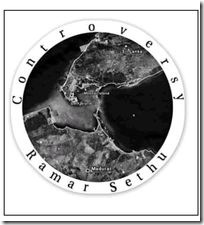 A massive agitation reminiscent of Ram Mandir campaign will be launched across the country from November 20 to protect Ramar Sethu, said Praveen Togadia, International General Secretary, Vishwa Hindu Parishad (VHP).
A massive agitation reminiscent of Ram Mandir campaign will be launched across the country from November 20 to protect Ramar Sethu, said Praveen Togadia, International General Secretary, Vishwa Hindu Parishad (VHP). 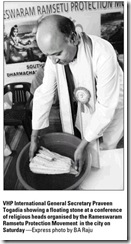 “The agitation, to be spread over a month, will be peaceful, but an aggressive democratic campaign covering more than 4 lakh villages is on the cards. A Shila Yatra carrying the floating stone, which is used to build Ramar Sethu, will be organised and prayers will be offered to it at 1,500 places across the country. It also cover places associated with Ram.” Speaking to journalists on the sidelines of a conference of Madathipathis, Dharmacharyas and religious scholars of south India under the auspices of Rameswaram Ramsethu Protection Movement, in the city, on Saturday, Togadia said that every village would be turned into an Ayodhya, where people would spearhead a campaign, if the Union Government failed to publicly declare that they would not destroy Ramar Sethu.” People would be encouraged to enrol in a `dharmayudha’ during the one-month yatra, which would start on November 20 and the target was one mil lion people, he said.
“The agitation, to be spread over a month, will be peaceful, but an aggressive democratic campaign covering more than 4 lakh villages is on the cards. A Shila Yatra carrying the floating stone, which is used to build Ramar Sethu, will be organised and prayers will be offered to it at 1,500 places across the country. It also cover places associated with Ram.” Speaking to journalists on the sidelines of a conference of Madathipathis, Dharmacharyas and religious scholars of south India under the auspices of Rameswaram Ramsethu Protection Movement, in the city, on Saturday, Togadia said that every village would be turned into an Ayodhya, where people would spearhead a campaign, if the Union Government failed to publicly declare that they would not destroy Ramar Sethu.” People would be encouraged to enrol in a `dharmayudha’ during the one-month yatra, which would start on November 20 and the target was one mil lion people, he said. 